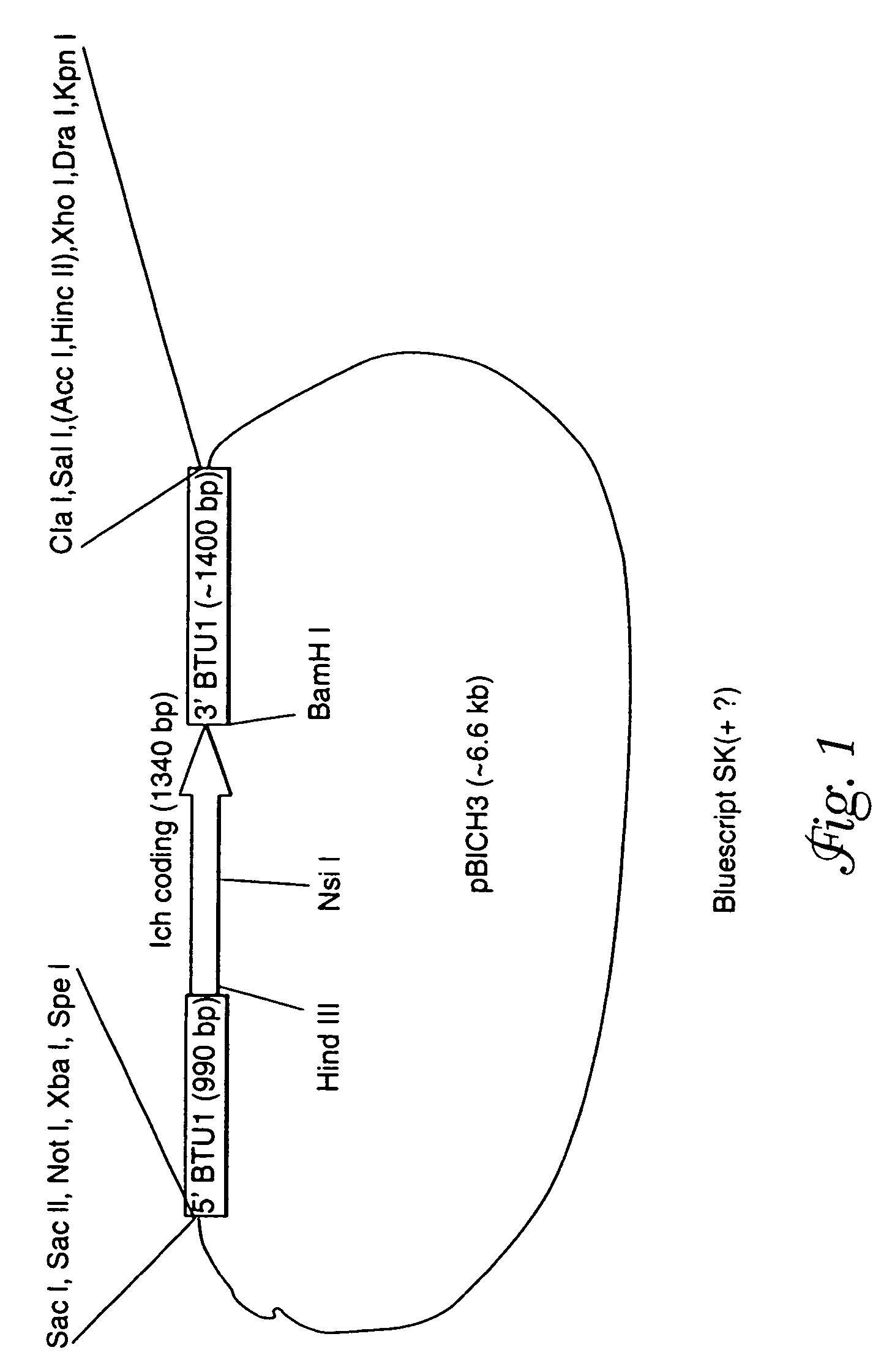Recombinant expression of heterologous nucleic acids in protozoa
a technology of heterologous nucleic acids and recombinant protein, which is applied in the field of recombinant protein production in nonpathogenic protozoa, can solve the problems of inability to provide many post-translational modifications of heterologous proteins, cultured insect cells and mammalian cells have a relatively long doubling time, and none of these systems is universally applicable for the production of all proteins
- Summary
- Abstract
- Description
- Claims
- Application Information
AI Technical Summary
Benefits of technology
Problems solved by technology
Method used
Image
Examples
examples
[0096]The following examples are provided for illustrative purposes only and are not intended to limit the scope of the invention.
[0097]The examples utilize many techniques well-known and accessible to those skilled in the arts of molecular biology, and in the transformation of Tetrahymena. Enzymes are obtained from commercial sources and are used according to the vendors' recommendations or other variations known in the art. Reagents, buffers and culture conditions are also known to the art. References containing standard molecular biological procedures include Sambrook et al. (1989) Molecular Cloning, Second Edition, Cold Spring Harbor Laboratory Press, Cold Spring Harbor, N.Y.; Wu (ed.) (1979) Methods Enzymol. 68; Wu et al. (eds.) (1983) Methods Enzymol. 100 and 101; Grossman and Moldave (eds.) (1980) Methods Enzymol. 65; Miller (ed.) (1972) Experiments in Molecular Genetics, Cold Spring Harbor Laboratory, Cold Spring Harbor, N.Y.; Old and Primrose (1981); Principles of Gene Mani...
example i
Plasmid Construction: pBAB1 and pICH3
[0100]The pBTU1 plasmid containing a 3.7 kb Bgl II / Hind III fragment of the Tetrahymena thermophila β-tubulin gene, BTU1, was used to construct a derivative, pBAB1, in which the entire coding sequence was replaced with the coding sequence of the neomycin resistance gene, neo1 (R. Kahn et al., Proc. Nat'l. Acad. Sci. USA 90:9295-9299 (1993)). Thus, the expression of neo1 gene on pBAB1 is driven by the flanking sequences of the BTU1 gene. The plasmid pBAB1 was used to construct another derivative in which the neo coding region was replaced with the entire coding sequence of the Ichthyophthirius i-antigen (isolate G1) pre-protein. T. G. Clark et al., Proc. Natl. Acad. Sci. USA, 89: 6363-6367 (1992). To this end, the pBAB1 plasmid was amplified with the NEO257 primer (5′-AGCCAGTCCCTTCCCGCTTCAGTGACAA-3′ (SEQ ID NO:9) (provided by J. Bowen and M. Gorovsky, University of Rochester, N.Y.) whose sequence encodes the antisense strand of the neo1 gene, and ...
example ii
DNA-Mediated Transformation of T. thermophila
Transformation
[0101]A Tetrahymena thermophila strain, CU522 (provided by Dr. Peter Bruns, Cornell University, Ithaca N.Y.) was used as a transformation host. This strain carries a single substitution (K350M) in the β-tubulin, BTU1 gene. This mutation was originally described for Chlamydomonas reinhardtii (Bolduc et al., Proc. Nat'l. Acad. Sci. USA 85:131-135 (1988)), and was later found to confer a similar phenotype in T. thermophila, namely, increased resistance to several microtubule depolymerizing drugs, such as oryzalin and colchicine, and increased sensitivity to a microtubule stabilizing agent, paclitaxel (J. Gaertig et al., Proc. Nat'l. Acad. Sci. USA 91:4549-4553 (1994)).
[0102]Cells were grown in 50 ml of SPP medium (J. Gaertig, Proc. Nat'l. Acad. Sci. USA 91:4549-4553 (1994)), supplemented with 100 U / ml penicillin, 100 μg / ml streptomycin and 0.25 μg / ml amphotericin B (SPPA medium), in 250 ml Erlenmayer flasks with shaking at 150...
PUM
| Property | Measurement | Unit |
|---|---|---|
| size | aaaaa | aaaaa |
| concentrations | aaaaa | aaaaa |
| density | aaaaa | aaaaa |
Abstract
Description
Claims
Application Information
 Login to View More
Login to View More - R&D
- Intellectual Property
- Life Sciences
- Materials
- Tech Scout
- Unparalleled Data Quality
- Higher Quality Content
- 60% Fewer Hallucinations
Browse by: Latest US Patents, China's latest patents, Technical Efficacy Thesaurus, Application Domain, Technology Topic, Popular Technical Reports.
© 2025 PatSnap. All rights reserved.Legal|Privacy policy|Modern Slavery Act Transparency Statement|Sitemap|About US| Contact US: help@patsnap.com



